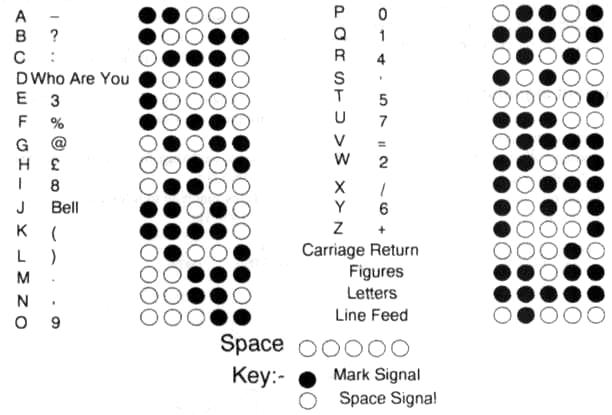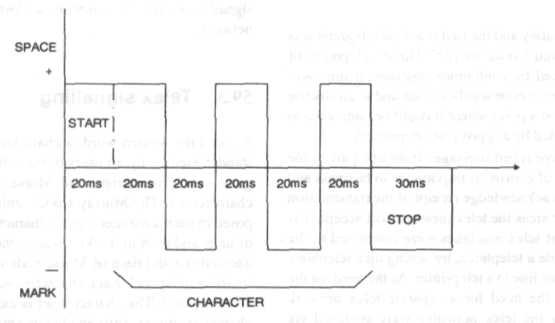
- •59 Telex communications
- •59.1 Introduction
- •59.2 Characteristics of telex
- •59.3 Telex signalling
- •59.3.1 Single current signalling
- •59.3.2 Double current signalling
- •59.3.3 Single channel voice frequency signalling
- •59.3.4 Type a and Type b signalling
- •59.4 Answerback
- •59.5 Telex protocol
- •59.6 Telex terminals
- •1. Learn the words & word combinations:
- •2. Read the text «Telex Communications».
- •3 Answer the following questions:
- •4. Retell the text according to your plan
- •5. Make a short report about three major signalling systems being in use throughout the world
- •6. Make a written translation of two passages about «Telex Protocol» (59.5)
59 Telex communications
59.1 Introduction
Telex has its roots in telegraphy and the first practical telegraph was installed by Wheatstone and Owke in 1857The development of telegraphy has been marked by continuous mechanical improvements. Hand sending of Morse code was laborious and so an electric typewriter was developed to a point where it could be connected to a telephone line and operated by a typist (the teleprinter).
The ability to send/receive typed messages from one part of the world to the other became ol enormous importance to business and as the machine was able to acknowledge receipt of the transmission of the information in some areas the telex message was accepted as a legally binding. The first telex machines were connected to the telephone network alongside a telephone, by setting up a telephone call and then transferring the line to a teleprinter. As the need for the service grew in business the need for a separate telex network became apparent. Initially the telex networks were switched via manual switchboards, but as they were exclusive to business use the networks were quickly converted to automatic working in the late 1950s.
59.2 Characteristics of telex
Telex differs from telephony in that it carries the written rather than spoken communication and is almost exclusively used in the business world. A key element of telex communication is the production of a local record, exactly duplicating the message sent to and received at the distant end. Further, telex can be operated with the distant end completely unattended, which makes it ideal for international working where businesses operate in differing time zones. As telex transmits the written word, then it also makes it ideal for communication between people of different languages, as time can be spent on translating the message and then formulating the reply. Since most countries that adopted telex also had a telephony network, they naturally used the telephony network as the basis for the design of the telex network, which in turn led to a wide variety of signalling systems to communicate between telex machines and the network
59.3 Telex signalling
To send the written word, a character set had to be produced and standardised on by all users of the telex system. As the teleprinter grew out of telegraphy and Morse code, then so did the telex character set. The Murray Gxie , unlike the Morse code, is composed in such a manner that all characters contain the same number of units and each unit takes exactly the same time to transmit. The unequal dot and dash of Morse code is replaced by equal duration 'mark' and 'space'. Each character requires 5 units giving 32 characters in total. The character set is extended by defining two shift characters, figures shift and letters shift.
This code makes up the basis of CCITT International Alphabet Number 2 which is fundamental to the operation of all telex machines (see Figure 59.1). As the telex service grew, the need for a more comprehensive character set was required, particularly when operating over high frequency radio circuits. The CCITT International Alphabet Number 5. with its 7 unit error detecting code and automatic retransmission to correct errors, was adopted for telex working and a translation defined between both character sets. In essence this meant that a TELEX machine sending in CCITT ITA 2 would be translated via a code conversion to CCITT ITA 5.
When a character is sent to line it is preceded with one start element followed by 5 information elements and then one stop element (see Figure 59.2). With the pulse durations shown in Figure 59.1, the telex operates at 50 bits per second.
A variety of line signalling systems exist for telex operation, using voltage and current signalling and mainly designed around the needs of electromagnetic systems, where the transmit and receive elements were contacts and electromagnets respectively, loiter single channel voice frequency signalling was added to the telex system. There are therefore three major signalling systems in use throughout the world all with minor country differences depending on the type of telex exchange operating in the local country. These are double current signalling, single current signalling, single channel voice frequency signalling, as described in the following sections. In addition some telex machines are connected to private networks or point to point private wires using similar signalling systems. The mode of working is also important i.e. full duplex discrete send and receive paths and half duplex common send and receive path. Public telex networks are invariably half duplex in operation.
Start Stop Signal Code

Figure 59.1 CCITT International alphabet number 2

Figure 59.2 Start stop telex signal
